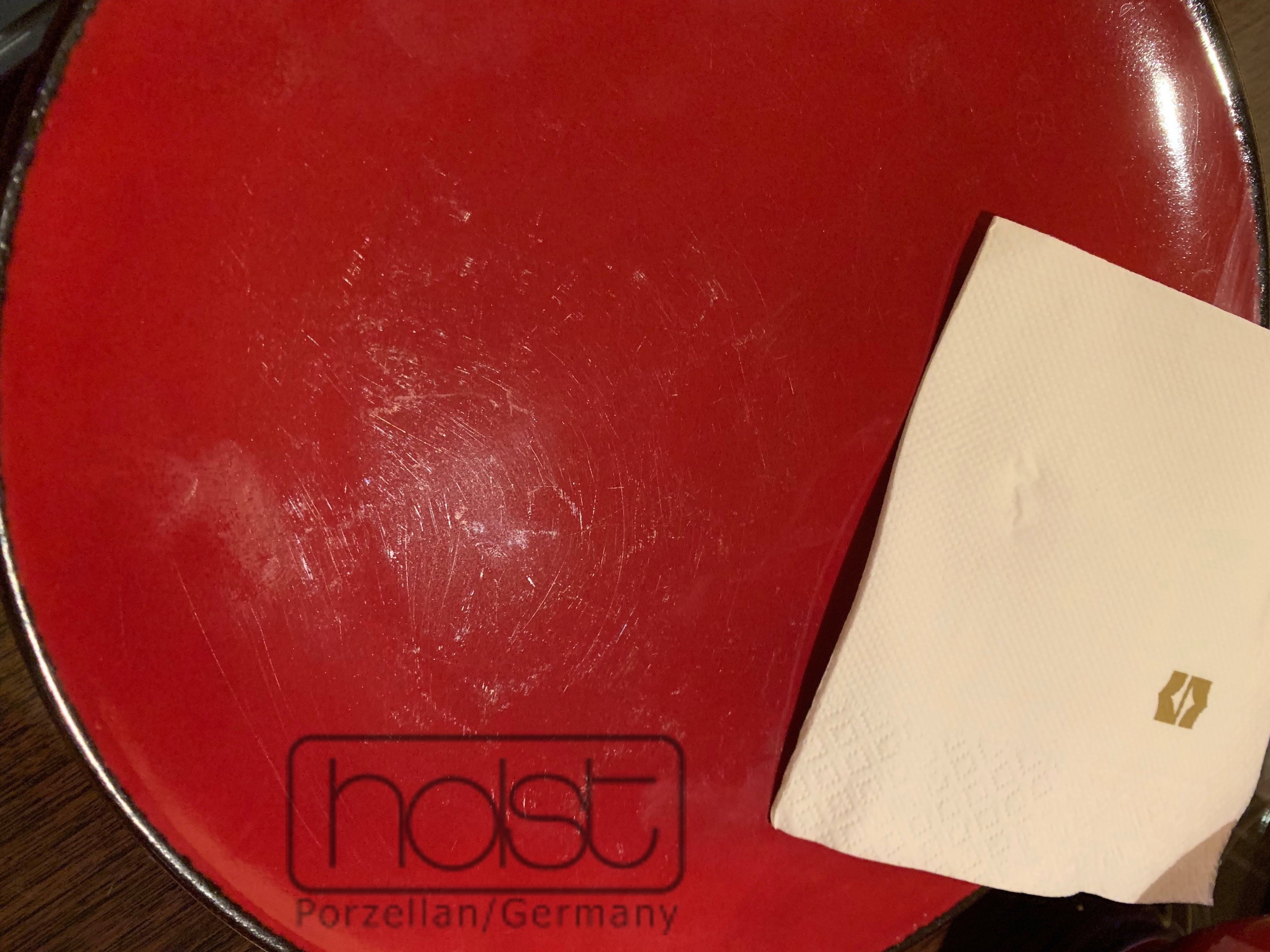Cutting Marks
Scratches as cutting marks in ceramic glazes
Cutting marks in porcelain, ceramics, stoneware and other ceramic shards
The group of mechanical destruction includes visible cutting marks caused mostly by knife blades. Contrary to the more familiar "cutlery abrasion", it is not the cutlery that has rubbed off the hard glaze of the ceramic body, but the cutlery has simply cut through the surface of the glaze. Chrome steel blades with around 3 to 4 Mohs can cut through the soft ceramic glazes under pressure.
The hardness of "real hard porcelain", on the other hand, is between 5 and 7 Mohs and cannot be "scratched" by the softer chrome steel or chrome-nickel steel (3 to 4 Mohs) - as it is called in technical jargon.
Is porcelain 100% cut-resistant?
Before you follow this article from the "Faults & features" section, it is advisable to familiarise yourself with the definition of cut resistance.
The answer to this question is "No"! Although porcelain is cut-resistant to chrome steel 13/0 and chrome nickel steel 18/0 and 18/10, it can be "scratched" by all harder materials. Porcelain can therefore scratch porcelain, especially if unglazed bases and setting rings are pushed or pulled over the smooth surfaces of a flat part. It is also possible to score porcelain with ordinary knife blades! Provided that rinsing residues or water deposits have settled on the porcelain itself or on the blades, usually in the small teeth of the saw blade. Our water, obtained from the groundwater of the respective region, contains a variety of minerals such as calcium carbonate, lime, quartz and many more.
Water droplets and grease residues on the porcelain itself are real magnets for the accumulation of mineral residues from the rinsing water. The compositions of residues that are as hard or harder than the glaze of the porcelain then originate from such a mineral pool.
However small and inconspicuous these residues may be, in combination with mechanical pressure they can cause clearly visible glaze damage on porcelain. Please read our article on solid residues from the application tips.
As an illustrative example of this effect, we like to compare rubber boots with a tiled floor. The clean, soft rubber sole of the boot causes at most a squeaking noise on a clean floor tile when you move your foot back and forth. If you make the same turns with minimal sand residue - also of mineral origin - under the sole, the tile will scratch.
Cutting marks on coloured tableware
The ceramic body of earthenware or porcelain stoneware usually contains a white, yellowish or brownish clay as a moulding mass. The porcelain body contains around 50% kaolin, which appears transparent and white. If a coloured glaze is damaged, the cutting mark penetrates the coloured glaze layer, depending on its intensity, and makes the body colour appear or shine through. As a result, all glaze damage on coloured tableware usually appears much worse and more extreme to the consumer than on white porcelain. Cutting and grinding marks on black, grey or dark blue coloured glazes appear even more disturbing than on white porcelain due to their extreme colour refraction on the glossy surface.
Coloured tableware, whether made of porcelain or ceramic, is always subject to a higher risk of visible glaze marks than white (glazed) porcelain!
Cutting marks on matt glazes
Porcelain makers have been glazing their earthenware since at least 1368 (see History of porcelain) in order to protect the body and improve the functional properties of the moulded ware. As the name suggests, the glaze on porcelain consists of a feldspar-containing glass mass that ensures a significant proportion of the functional properties. If this type of glaze is omitted or replaced by modern matt glazes (which are not glazes), this increases the vulnerability of the ceramic object to an extreme degree. Matt glazes are therefore subject to a higher risk of signs of wear than glazed crockery.
Loss of suitability for use
Heavily scratched glazes on ceramic crockery (see picture above) not only result in an unattractive appearance, but also generally lead to the loss of its property as a food contact article. Depending on the type of body and glaze, ingredients can corrode or oxidise and foreign substances from food residues can settle in the cracks and crevices.
Porcelain is different. The much denser, higher-fired body and the glaze make corrosion and the absorption of foreign substances almost impossible.
Misleading product names
The incised ceramic shown in the picture above is/was labelled as "porcelain" by its manufacturer and was also sold as porcelain by most of the trading partners. The motto is that what the manufacturer says is true. It should be noted that the term "porcelain" is not standardised internationally and is subject to different interpretations. Many manufacturers refer to their ceramics as porcelain because biscuit firing (first firing) takes place at temperatures above 1,300 °C. The glaze firing (glaze firing) takes place at temperatures above 1,300 °C. Smooth firing (glaze firing), however, takes place in temperature ranges that are only between 950 and 1,100 °C. This means that smooth firing is lower than glaze firing. Smooth firing is therefore lower than first firing. The different firing temperatures alone make it clear that the glaze is softer than the underlying body. And this is precisely the difference to real porcelain.
According to the German porcelain theory, such ceramic crockery is earthenware! Earthenware crockery is only suitable for commercial use to a limited extent and for a short time.

